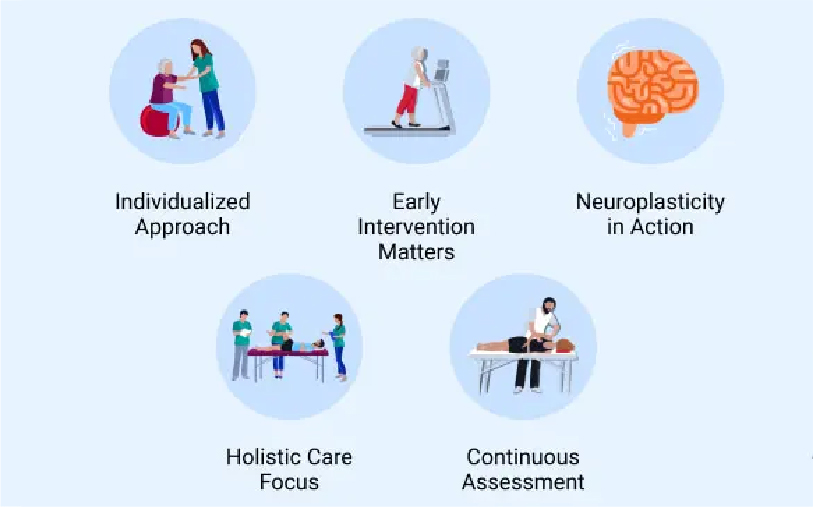Neuro rehabilitation is a specialized treatment designed to help individuals facing challenges with their brain and spinal cord. Neurorehabilitation supports recovery from conditions like stroke, traumatic brain injury, spinal cord injury, or Parkinson's disease. It helps individuals regain the ability to perform daily activities and help them get back on track by providing them with specialized support from expert rehabilitation specialists..
The individualised approach is what distinguishes a brain rehabilitation centre from other rehabilitation centers. A generic treatment approach is not enough. The group must spend time learning about the person, including their goals, challenges, and strengths.
 What is Neurorehabilitation?
What is Neurorehabilitation?Neuro rehabilitation focuses on treating debilitating conditions like stroke and traumatic brain injuries through therapies that promote brain regeneration and recovery. Treatments include therapies that stimulate the nervous system, promote learning, and encourage brain reorganization to restore function.
Since 2000, neurorehabilitation therapies have proliferated in tandem with a paradigm shift in neurologic care. The notion that a brain injury, like a stroke, has a permanent impact on function, activity, and participation was abandoned in the middle of the 20th century. Instead, we learnt about the brain's capacity for regeneration and dynamic brain reorganisation months or even years later. In order to determine the permissive circumstances for optimal brain change and recovery, neurorehabilitation scientists advocated for translational research, which seems to require regulated, intense stimulation of damaged brain networks.
Read Also: The 5 Most Common Mental Disorders: What You Need to Know?
Following are the numerous types of neurorehabilitation:
Acute Neurological Rehabilitation: Rehabilitation is often thought of as the process of recovering from an acute injury, such as a stroke, head injury, spinal cord damage, etc. However, as people who require this kind of treatment usually have had an acute injury to their brain, spinal cord, or nerves, the term "acute neurological rehabilitation" could be more suitable. Acute neurological rehabilitation aims to accomplish more than only allowing your system to recover. Through a variety of therapies, you can enhance your physical abilities and muscle fitness while also strengthening your mental and emotional capabilities. In addition, you might receive medications for improving physical activity, dietary advice, and nutritional counselling, as well as access to psychiatric, educational, and career assistance.
Post-Acute Neurological Rehabilitation: Acute healing is not as important as long-term treatment in post-acute neurological rehabilitation. With the correct care, you may overcome some of the physical and emotional obstacles that may hold you back for years. Services for post-acute neurological rehabilitation usually aim to help you become completely independent. In other words, you want to be able to manage all of your essential needs—such as health, well-being, and personal care—without requiring significantly more help. Additionally, it also helps you in enabling you to carry out necessities such as eating, clothing, taking a shower, and maintaining your own survival.
Sub-Acute Neurological Rehabilitation: Sub-acute rehabilitation is a period of your treatment that is a part of both the acute and post-acute phases, rather than a rehabilitation phase in and of itself. Only the duration of sub-acute rehabilitation is longer than that of acute rehabilitation. You are entering post-acute rehabilitation after completing sub-acute therapy. After completing sub-acute rehabilitation, you will probably be referred to post-acute rehabilitation. Compared to the first two forms of rehabilitation, sub-acute rehabilitation is usually characterised by more intensive therapies, more complex treatments, and more group sessions. In order to assist you return to a productive, independent, and satisfying life, you will continue to receive neurological therapy.
Read Also: Factors to Consider While Choosing the Best Rehab Center in Hyderabad
Numerous medical conditions can affect the neurological system. Neurological rehabilitation may be beneficial for the following conditions:
Read Also: 10 Tips for Good Mental Health: How to Take Care of Your Mind
Depending on your particular issue or illness, a neurological rehabilitation program is tailored to your needs. Your family's and your own active participation is essential for the program's success. Restoring your maximum level of independence and function is the aim of neurological rehabilitation. It also aims to enhance your quality of life, including your social, emotional, and physical well-being. Following is included in neurorehabilitation program:
Read Also: Multiple Sclerosis Treatment in Hyderabad
Looking for the best neurorehabilitation center in India? Experience world-class care with advanced therapies designed to restore mobility, strength, and independence. Tailored treatment plans and expert professionals ensure optimal recovery for neurological conditions.
Neuro rehabilitation aims to restore function, promote independence, and enhance quality of life for individuals with neurological conditions. in people who have significant disabilities brought on by injuries in the central nervous system.
Discover how neurorehabilitation therapies can improve mobility, rebuild strength, and enhance your overall quality of life. Explore personalized therapies at Walk Again to regain independence and achieve your recovery goals.
Q1: How does neurorehabilitation work?
A: It combines physical, occupational, and cognitive therapies to retrain the brain and body, enhance mobility, and restore independence in daily activities.
Q2: Who can benefit from neurorehabilitation?
A: People recovering from stroke, traumatic brain injury, Parkinson's disease, multiple sclerosis, or spinal cord injuries can benefit greatly from neuro rehabilitation.
Q3: How does neurorehabilitation improve quality of life?
A: It improves mobility, enhances independence, reduces pain, and boosts overall physical and emotional well-being through targeted therapies and exercises.